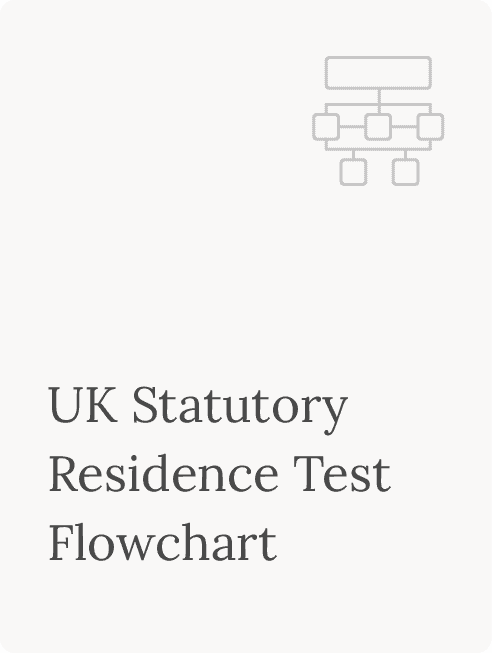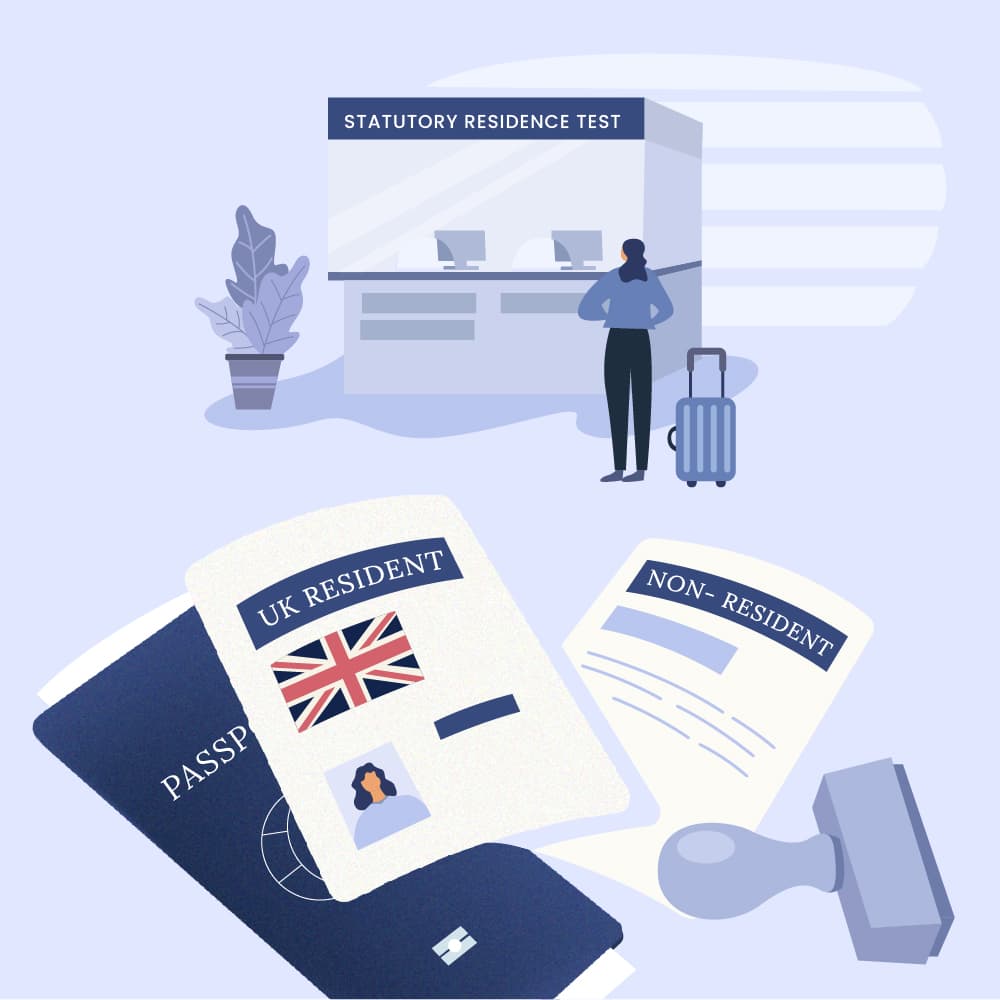Understanding the Statutory Residence Test UK can be confusing and complicated. Whether you’re an expat, a global professional, or considering a move across borders, understanding your tax residency status is crucial to managing your finances effectively.
With the Statutory Residence Test in the UK determining your obligations for income tax, capital gains tax, and more, getting to grips with its criteria is essential.
Our guide simplifies the UK Statutory Residence Test process, explaining automatic overseas and UK tests, to the sufficient ties test and split year treatment to ensure your tax planning is as efficient and stress-free as possible.
What You Will Learn
- What the UK Statutory Residence Test is, and how it impacts your tax status?
- The criteria for the automatic overseas, UK tests, and sufficient ties test.
- How to strategise your UK and overseas stays to align with tax residency goals.
- Understand split year treatment for mid-year residency changes.
- How to prepare effectively for the UK Statutory Residence Test.
What Is the Statutory Residence Test?
The Statutory Residence Test (SRT) determines your tax residency status within the UK for any given tax year.
The SRT test provides a framework to evaluate whether you qualify as a resident in the UK for the following UK tax purposes:
- Income Tax.
- Capital Gains Tax.
- Inheritance Tax.
- Corporation Tax.
It decides how many days you can spend in the UK before you are deemed a UK tax resident.
The UK Statutory Residence Test considers each tax year independently, meaning your residency status may vary yearly.
Understanding your tax residency status is important, as it will dictate the income and gains you need to report to HM Revenue and Customs (HMRC).
How Does the Statutory Residence Test UK Work?
The Statutory Residence Test UK works as a three-step test to accurately determine your UK tax residency status and understand your tax obligations.
Each step has specific criteria. The three steps are:
- Automatic overseas test.
- Automatic UK test.
- Sufficient ties test.
Each step needs to be reviewed in turn and if a conclusion is not reached you move on to the next. As soon as your situation meets the criteria at any step, your residency status is decided.
Therefore, If you are determined to be a non-resident through the automatic overseas tests, there is no need to consider the subsequent tests.
When Am I Not Classified as a UK Resident for Tax Purposes
You will not be considered a UK resident for tax purposes if:
- You meet the requirements of the automatic overseas test;
- Or you fail to pass the automatic UK test and keep within your allowed UK visiting limit according to the sufficient ties test.
Below, we will look at each test’s requirements in more detail.
Automatic Overseas Tests
The automatic overseas tests are designed to establish if you are considered a non-resident in the UK for tax purposes.
The HMRC automatic overseas tests are the first step in the Statutory Residence Test process. They determine if you are not a UK resident based on specific factors like your days spent in the UK and work habits.
There are five automatic overseas tests. If you meet the criteria for any of these tests, you will be regarded as a non-UK resident for the relevant tax year.
First Automatic Overseas Test
The first automatic overseas test applies if you spent fewer than 16 days in the UK during the current tax year and were a UK resident in one or more of the three preceding tax years.
Second Automatic Overseas Test
The second automatic overseas test applies if you have not lived in the UK in one or more of the three previous tax years and have spent fewer than 46 days in the UK during the tax year.
Third Automatic Overseas Test
The third automatic overseas test applies if you have worked ‘sufficient hours’ abroad over the tax year, with no ‘significant breaks’ from overseas work, and spent fewer than 91 days in the UK, of which no more than 30 days working.
What Is ‘Sufficient Hours Abroad’ Defined As?
‘Sufficient hours abroad’ is considered when you work at least 35 hours per week during the tax year. This calculation is based on the total hours worked abroad divided by the number of weeks worked.
What Is a ‘Significant Break’ Defined As?
A ‘significant break’ is considered a period of at least 31 consecutive days during which you do not work more than 3 hours per day, and the absence of work is not due to annual leave, parental leave, sick leave, or reasonable days off.
To ensure compliance with the third automatic overseas test, you should keep detailed records of your work hours, breaks from work, and days spent in the UK is essential to help your claim of non-residency to HMRC.
The remaining two tests cover the position where an individual dies during the year.
As you navigate the automatic overseas tests, it’s crucial to consider how double taxation agreements between the UK and other countries might affect you.
Automatic UK Tests
The four automatic UK tests are applied if you don’t meet any of the automatic overseas tests. You will be considered a UK resident for the tax year if you meet any automatic UK tests.
First Automatic UK Test
The first automatic UK test considers your physical presence in the UK. You are resident in the UK for the tax year if:
You spend 183 days or more in the UK during the tax year.
Second Automatic UK Test
The second automatic UK test focuses on your home in the UK. You meet this test if:
- You have a home in the UK for a period of at least 30 consecutive days during the tax year, and;
- During this period, there is at least one period of 91 consecutive days when you have a UK home, and at least 30 days of this period fall within the tax year and;
- You are present in that UK home for at least 30 days during the tax year, and;
- During the tax year, you have no overseas home where you spend significant time.
Third Automatic UK Test
The third automatic UK test assesses your work activity in the UK. You meet this test if:
- You ‘work full-time in the UK’ for any period of 365 days, with no ‘significant break’ from UK work, and;
- More than 75% of your total workdays in the 365-day period are spent working in the UK and;
- At least one day of the 365-day period falls in the tax year.
If you meet any of these automatic UK tests, you are classified as a UK resident for that tax year.
If, however, your residency status remains unclear, the sufficient ties test may be used to clarify your residency status further based on additional connections to the UK.
UK Sufficient Ties Tests
If your residency status cannot be conclusively determined through the automatic overseas and automatic UK tests, the UK sufficient ties test is next.
This part of the Statutory Residence Test evaluates your connections – or ‘ties’ -to the UK to decide your residence status.
The sufficient ties test is relevant as the number of ties needed to be considered a UK resident varies depending on whether you are arriving in or leaving the UK.
- You are determined as an ‘arriver’ if you have been a non-resident in all of the three tax years preceding the tax year under consideration.
- You are determined as a ‘leaver’ if you have been a resident in one or more of the three tax years preceding the tax year under consideration.
The number of connecting ties with the UK that apply for the year are reviewed using the following five UK sufficient ties tests:
- Family tie.
- Accommodation tie.
- Work tie.
- 90-day tie.
- Country tie.
Family Tie
For both ‘arrivers’ and ‘leavers’, having either of the following living in the UK constitutes a family tie:
- Spouse.
- Civil partner.
- Minor child.
Accommodation Tie
The accommodation tie assesses your connection to the UK through living arrangements. You establish an accommodation tie if:
- A residential property in the UK is available for your use as a place of residence.
- The property is available for your use for a continuous period of at least 91 days during the tax year.
- You spend at least one night in the tax year at that property.
An important consideration in evaluating this tie is the relationship with the property owner and the duration of your stay:
If the accommodation is owned by close family members, such as parents, grandparents, siblings, or adult children and grandchildren, staying at the property for up to 15 nights in the tax year does not, by itself, establish an accommodation tie.
Work Tie
The work tie assesses the level of work activity conducted in the UK during the tax year. This tie is triggered if:
- You work in the UK for at least 40 days in the tax year.
- A ‘day of work’ is any day you perform more than 3 hours of work in the UK. This includes any day where you are not in the UK at the end of that day.
90-day Tie
The 90-day tie statutory residence test examines the number of days spent in the UK in previous tax years. The 90-day tie is triggered if:
You spend more than 90 days in the UK in either or both of the two tax years immediately preceding the current tax year.
Country Tie
The country tie applies only if you have been classified as a UK resident for at least one of the preceding three tax years. It assesses where you predominantly spend your time during the tax year.
The criteria for establishing a country tie are clear:
- You have a country tie if the UK is where you spend the most days throughout the tax year.
Counting UK Days for the Statutory Residence Test
When determining the number of days spent in the UK for the Statutory Residence Test:
- A day is generally counted as a ‘UK day’ if you are present in the UK at midnight. However, there are exceptions for individuals transiting through the UK without a significant stopover.
- Days of departure are not typically included in the count of UK days for the SRT, except for the application of the deeming rule outlined below.
The Deeming Rule
The deeming rule comes into play under specific conditions, further refining how days are counted:
- It applies if you were a UK resident in any of the three tax years preceding the current tax year and
- You have at least three UK ties for the current tax year.
Under this rule, the ability to exclude days of departure from the UK day count is limited, with a maximum of 30 departure days eligible for exclusion.
Will I Be Classified As A UK Resident Under The Sufficient Ties Test?
The tables below show the relationship between the number of days spent in the UK and the required number of ties for both arrivers and leavers to be considered UK residents under the Sufficient Ties Test.
| For Individuals Non-Resident Throughout the Three Prior Tax Years (Arrivers) | ||||
|---|---|---|---|---|
| Number of days in the UK in the tax year | 1 or No UK ties | 2 UK ties | 3 UK ties | 4+ UK ties |
| Fewer than 16 days | Non-Resident | Non-Resident | Non-Resident | Non-Resident |
| 16 to 45 days | Non-Resident | Non-Resident | Non-Resident | Non-Resident |
| 46 to 90 days | Non-Resident | Non-Resident | Non-Resident | Resident |
| 91 to 120 days | Non-Resident | Non-Resident | Resident | Resident |
| 121 to 182 days | Non-Resident | Resident | Resident | Resident |
| 183 days plus | Resident | Resident | Resident | Resident |
| For Individuals Resident in the UK in Any of the Three Prior Tax Years (Leavers) | ||||
|---|---|---|---|---|
| Number of days in the UK in the tax year | 1 or No UK ties | 2 UK ties | 3 UK ties | 4+ UK ties |
| Fewer than 16 days | Non-Resident | Non-Resident | Non-Resident | Non-Resident |
| 16 to 45 days | Non-Resident | Non-Resident | Non-Resident | Resident |
| 46 to 90 days | Non-Resident | Non-Resident | Resident | Resident |
| 91 to 120 days | Non-Resident | Resident | Resident | Resident |
| 121 to 182 days | Resident | Resident | Resident | Resident |
| 183 days plus | Resident | Resident | Resident | Resident |
Statutory Residence Test Exceptional Circumstances
The Statutory Residence Test includes provisions for ‘exceptional circumstances’ that can affect the days spent in the UK.
These provisions are designed to offer flexibility in situations where your presence in the UK is beyond your control.
Understanding Exceptional Circumstances
Exceptional circumstances are specific events or situations that mean you have to remain in the UK beyond your planned time, potentially affecting your residency status.
The Statutory Residence Test allows up to 60 days to be disregarded in certain situations when counting your days in the UK, provided these days result directly from exceptional circumstances.
Exceptional circumstances may include, but are not limited to, the following scenarios:
- Sudden or life-threatening Illness or Injury: If you or a close family member becomes seriously ill or suffers an injury while in the UK, requiring your presence.
- Natural disasters: Events such as earthquakes, floods, or volcanic eruptions that prevent you from leaving the UK as planned.
- Civil unrest or war: Situations where political instability, civil unrest, or war conditions in another country prevent you from returning to that country from the UK.
- Travel disruptions: Severe and unexpected disruptions to travel, including pandemics, that stop you from leaving the UK. This might include cancelled flights due to volcanic ash clouds or border closures.
Understanding Temporary Non-Residence and Its Tax Implications
Temporary non-residence is a UK tax law that applies to individuals who leave the UK and return within a short period, affecting how they are taxed on their worldwide income and gains during their absence.
Temporary non-residence prevents individuals from artificially arranging their affairs to avoid UK tax by briefly becoming non-resident.
You are classed as a temporary non-resident if you have been a UK resident in four of the seven years before leaving the UK and then return to become a UK resident within five tax years.
If classed as a temporary non-residence, you will be taxed on:
- Capital gains on assets held before departure.
- Any dividends from close companies deriving from profits arising before departure.
- Lump sum pension benefits from Employer Financed Retirement Benefit Schemes (EFRBS).
- Chargeable event gains on life assurance.
If you intend to return to the UK within five years, seeking guidance from a professional tax adviser is recommended to manoeuvre through these regulations.
Overseas Workday Relief
Overseas workday relief is a UK tax relief available if you are non-UK domiciled under the Statutory Residence Test and choose to be taxed on a remittance basis.
Overseas workday relief can significantly reduce your UK tax liability if you work both in the UK and abroad by allowing you to only pay UK tax on the portion of your employment income related to your UK workdays.
Here’s a closer look at how overseas workday relief works:
- You must be a UK resident in the tax year, and non-UK domiciled.
- You need to claim the remittance basis of tax for the year you want to claim.
- The relief applies to income from employment worked outside of the UK.
- If you are eligible, only the income related to the workdays spent in the UK is subject to UK tax.
- You can claim overseas workday relief for the first three years of UK tax residency.
Split Year Treatment and the Statutory Residence Test
The split year treatment within the Statutory Residence Test addresses the complexities of changing residency status during a tax year, providing a mechanism for individuals who either leave or return to the UK partway through the tax year.
This approach allows the tax year to be divided into two distinct parts:
- One where the individual is considered a UK resident and
- One where they are considered non-resident.
Understanding Split Year Treatment
Split year treatment is applicable in eight specific scenarios or ‘cases’, each defined by its criteria to accommodate different circumstances of arriving in or leaving the UK – refer to HMRC’s RDRM12000 for further details.
This ensures that individuals’ tax obligations accurately reflect their residency status and connections to the UK during the year.
Cases for Leaving the UK
For individuals leaving the UK, split year treatment can apply under three primary scenarios:
- Starting full-time work overseas: You must have been a UK resident in the preceding year, undertaken full-time work abroad, and limited your visits back to the UK within pro-rata restrictions.
- Accompanying a partner working full-time overseas: Similar conditions apply, emphasising the need for a clear break from the UK.
- Ceasing to have a UK home: Indicating a move to live abroad permanently or for an extended period.
Cases for Arriving in the UK
For those arriving in the UK, scenarios include:
- Establishing the only home in the UK: Signifying the UK as your primary place of residence.
- Starting full-time work in the UK: Indicating a significant economic connection to the UK.
- Ceasing full-time work overseas: Transitioning from work abroad to living in the UK, possibly with or without immediate employment.
- Accompanying a partner returning to the UK: After their period of full-time work overseas.
- Starting to have a home in the UK: Establishing a residence in the UK, whether rented or owned.
What You Should Consider For Split Year Treatment?
Strict criteria and previous residency: Eligibility for split year treatment, especially when leaving the UK, requires meeting stringent criteria, including evidence of a significant lifestyle change and adherence to the rules about the number of days spent in the UK after departure.
Pro-rata limitations on UK visits: After leaving the UK, maintaining the non-resident part of the year under split year treatment necessitates careful management of time spent back in the UK to ensure it does not exceed specified limits.
Deeming rule for counting days: The deeming rule may apply, particularly affecting how days of departure from the UK are counted, restricting the exclusion of such days to a maximum of 30 if you have been a UK resident in one of the previous three years and have at least three UK ties.
How Split Year Treatment Impacts Your Tax Obligations?
Split year treatment significantly impacts how you are taxed on:
- Income tax on worldwide earnings and gains.
- Capital gains tax on the disposal of assets.
When applied, it means that for part of the year, your foreign income and gains may not be subject to UK tax, aligning your tax obligations more closely with their actual residency status and lifestyle during the tax year.
Navigating the challenges of split year treatment demands a thorough understanding of the criteria for each specific case, making it challenging. Seeking professional cross-border financial advice is highly recommended to ensure precise application and adherence to UK tax laws.
If you’re considering returning to the UK after a period abroad, understanding the implications of repatriation on your tax status is crucial.
Our UK Repatriation service provides tailored advice and support to ensure a smooth transition back to UK residency, addressing the nuances of the split year treatment and how it applies to your circumstances.
Statutory Residence Test Flowchart
The Statutory Residence Test Flowchart is a visual tool designed to simplify the process of determining your tax residency status in the UK.
It guides you through the various tests and conditions outlined in the SRT, including the automatic overseas tests, automatic UK tests, and the sufficient ties test. It visually breaks down the criteria and decision points, making it easier to follow.
By following the flowchart, you can navigate the complexities of the Statutory Residence Test more clearly.
Download our Statutory Residence Test Flowchart for a user-friendly guide to determining your UK tax residency status.
The flowchart is designed to provide precise, step-by-step assistance, ensuring you consider all relevant factors and tests for the Statutory Residence Test.
However, considering the complexities involved with the Statutory Residence Test, we advise consulting with a professional specialising in cross-border financial advice to ensure accurate application and compliance with UK tax laws.

Flowchart
UK Statutory Residence Test Flowchart
Our Statutory Residence Test Flowchart is designed to help you start unravelling the complexities, providing a visual outline of the key steps. Download now.
The Impact of SRT on Expats
The Statutory Residence Test has significant implications for British expats living and working outside the UK or those considering moving abroad.
Understanding the UK Statutory Residence Test is crucial for expats to accurately determine their UK tax residency status, which directly affects their tax obligations to the UK government. Here’s how the SRT impacts expats:
- Determining tax residency status: This determination is vital as it dictates whether you are liable for UK taxes on your worldwide income and gains or only on your UK-sourced income.
- Worldwide income and gains: For expats deemed UK residents, your global income and gains, including earnings from employment, rental income from overseas properties, and profits from foreign investments, are subject to UK tax. Non-residents, however, are generally taxed only on their UK-sourced income.
- Split year treatment: Expats moving to or from the UK part way through a tax year may benefit from split year treatment, allowing you to be taxed as a UK resident only for the part of the year they were in the UK. This is particularly relevant for those who permanently relocate in the middle of a tax year, ensuring you are not unfairly taxed after you have moved.
- Impact on investments and retirement planning: As an expat, your investment and retirement planning can be affected by your UK tax residency status. The tax treatment of pensions, savings, and investments may vary substantially depending on whether you are considered a UK resident or non-resident under the Statutory Residence Test.
The SRT’s impact on expats is profound, influencing their tax obligations, financial planning, and lifestyle decisions.
By accurately determining your residency status, you can ensure you meet your tax obligations while potentially minimising unnecessary liabilities.
Given the complexities and nuances of the Statutory Residence Test, seeking professional advice is highly recommended to navigate this critical aspect of expat life effectively.
How to Prepare for the Statutory Residence Test
Preparing for the Statutory Residence Test is essential for you to accurately determine your tax residency status in the UK. Here are key steps and considerations to effectively prepare for the SRT:
Understand the SRT Framework
Begin by understanding the three main components of the SRT- the automatic overseas tests, the automatic UK tests, and the sufficient ties test. You can download the Statutory Residence Test here.
Keep Detailed Records
- Track days spent in the UK: Maintain a detailed record of the days you spend in the UK, noting the dates of arrival and departure. Remember, the SRT often considers a day in the UK as any day you are in the country at midnight.
- Document work patterns: For both the automatic overseas and UK tests, your work pattern is crucial. Keep records of where and when you work, especially if you’re claiming full-time work abroad.
- Accommodation records: Document your living arrangements, including addresses, rental agreements, or ownership details, to support or refute an accommodation tie.
- Family and social ties: Note any significant family ties or social connections to the UK, as these can influence your residency status under the sufficient ties test.
Review Previous Years
Analyse your residency status and ties to the UK in previous tax years, as these can impact your current year’s status, especially for determining if you qualify for split year treatment.
Plan Your Travel and Work
- Strategic planning: If nearing the threshold that might change your residency status, carefully plan any work or personal travel to the UK or abroad. This planning can help you maintain your desired residency status.
- Understand the work tie: If working in the UK, be mindful of the 40-day threshold that could establish a work tie under the sufficient ties test.
Consult With Tax Professionals
Given the complexity of the SRT and its significant impact on your tax obligations, seek advice from tax professionals, especially those experienced in cross-border taxation.
Preparing for the Statutory Residence Test requires a comprehensive approach, including thorough documentation, an understanding of the tests involved, and strategic planning of your time in and out of the UK.
By taking these steps, you can accurately determine your residency status and manage your tax obligations effectively.
Consulting with professionals is highly recommended to navigate the complexities of the UK Statutory Residence Test and ensure compliance with UK tax regulations.
Statutory Residence Test Guidance
At AHR Group, we understand that navigating the complexities of the UK Statutory Residence Test can be daunting and fraught with the potential for costly mistakes that could seriously impact your plans and the net income you were expecting.
Mistakes in determining your tax residency status can lead to significant financial implications, underscoring the importance of getting it right the first time.
That’s why we offer comprehensive Statutory Residence Test guidance tailored to your unique circumstances, ensuring you can manage your tax obligations effectively and confidently.
Our expert team specialises in UK expat tax advice and is dedicated to providing personalised advice, whether you’re moving to the UK, planning to leave, or living abroad.
What We Offer
- Tailored advice: Personalised consultations to understand your situation and provide clear, actionable advice on your tax residency status and obligations.
- UK Repatriation Service: Specialised support for individuals returning to the UK, including guidance on the split-year treatment and how it affects your tax status.
- Record-keeping assistance: Help maintain detailed records essential for the SRT, including days spent in the UK, work patterns, accommodation, and family ties.
- Strategic planning: Expert advice on planning your travel and work to align with your tax residency goals, helping you avoid unwanted changes in your tax status.
- Professional navigation: Assistance in understanding and applying the complex criteria of the Statutory Residence Test to your advantage.
- Ongoing support: Continuous advice and support as tax laws evolve and circumstances change.
Take Control of Your Tax Residency
Don’t let the complexities of the Statutory Residence Test overwhelm you. With AHR Group, know that you have a partner dedicated to helping you navigate your tax residency easily.
Whether you’re concerned about income tax, capital gains, or inheritance tax implications, our team ensures your tax planning is efficient, compliant, and tailored to your needs.
Book Your 15-Minute Discovery Call
Unlock clarity on your tax situation with a 15-minute discovery call. This brief conversation is designed to provide immediate value, giving you insights and direction on your next steps. Here’s what you’ll gain:
- Quickly assess if your situation needs further assistance.
- Preview what a tailored tax plan could look like for you.
- Hear examples of how others in similar situations have benefited from our advice.

Key Takeaway
The UK Statutory Residence Test determines your tax residency status, impacting how you are taxed on income and gains worldwide.
Understanding the framework is essential for accurately assessing your residency and navigating the complexities of UK tax obligations.
Whether moving to the UK, leaving, or living abroad, the Statutory Residence Test can significantly impact your finances from income tax to capital gains and inheritance tax.
You should understand the importance of planning and record-keeping, highlighting the need for strategic management of days spent in the UK and abroad, understanding work patterns, and maintaining evidence of ties to the UK.
Understanding the Statutory Residence Test demands a thorough grasp of its criteria and the ability to apply these to your situation, often requiring professional cross-border financial advice to ensure precise application and compliance with UK tax laws.
Given the potential for significant financial implications, seeking expert guidance is not just recommended; it’s a critical step.
Download our detailed Statutory Residence Test Flowchart for a step-by-step visual guide, and contact us today for expert advice tailored to your unique circumstances.













